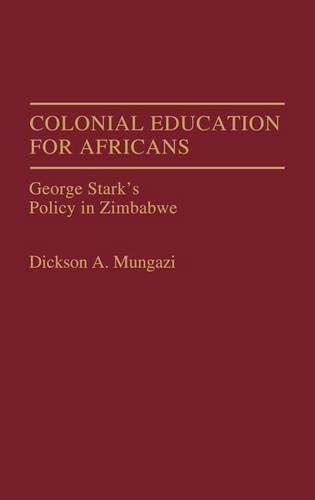
Colonial Education for Africans: George Stark's Policy in Zimbabwe
(Hardback)
Publishing Details
Colonial Education for Africans: George Stark's Policy in Zimbabwe
By (Author) Dickson Mungazi [Deceased]
Bloomsbury Publishing PLC
Praeger Publishers Inc
11th December 1991
United States
Classifications
Tertiary Education
Non Fiction
Social and cultural history
370.96891
Physical Properties
Hardback
176
Width 156mm, Height 235mm
510g
Description
Although colonialism has officially been terminated, it continues to affect populations who recent history has been shaped by European institutions, economic policies, and cultural biases. Focusing on British educational policy in colonial Zimbabwe, this historical study offers a unique perspective on the subject. It provides a detailed examination of a British educational programme for Africans established in the 1930s, the purposes it was intended to serve, and its long-term consequences. A policy of "practical training and tribal conditioning" was designed and implemented by George Stark, director of Native Education in colonial Zimbabwe from 1934 to 1954. Expressing the philosophy and goals of both stark and the British colonial government, its stated purposes were to develop a vast pool of cheap unskilled manual labour and to confine the African population to tribal settings. Dickson Mungazi discusses the policy as at once a reflection of traditional Victorian socio-cultural attitudes and the means to maintain a colonial status quo that allowed the profitable exploitation of the colony's material and human resources. The author examines the consequent educational and economic disabilities suffered by the African population and the impact of their long exclusion from an effective role in the affairs of their country. This study is based on research utilizing extensive original materials from the period, including reports and official colonial government documents.
Reviews
The greatest strength of the book is Mungazi's use of sources. Relying on primary documentation from missionary materials, government ordinances, and commission reports, Mungazi discovers the thoughts of the important actors, especially those of George Stark. Extensive use of these sources throughout the chapters and the inclusion of many in the fourteen appendices afford the reader the opportunity to evaluate Mungazi's often subjective conclusions.-History of Education Quarterly
"The greatest strength of the book is Mungazi's use of sources. Relying on primary documentation from missionary materials, government ordinances, and commission reports, Mungazi discovers the thoughts of the important actors, especially those of George Stark. Extensive use of these sources throughout the chapters and the inclusion of many in the fourteen appendices afford the reader the opportunity to evaluate Mungazi's often subjective conclusions."-History of Education Quarterly
Author Bio
DICKSON A. MUNGAZI is Professor in the Center for Excellence in Education at Northern Arizona University.
